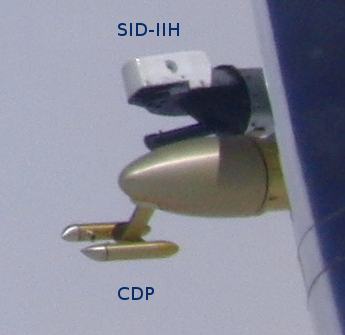Cloud Droplet Probe
-
 The Cloud Droplet Probe (CDP) mounted alongside the SID-IIH under the wing of the GV.
The Cloud Droplet Probe (CDP) mounted alongside the SID-IIH under the wing of the GV. -
This instrument, which is an updated version of the FSSP, uses a focused beam from a diode laser and detects light scattered from that beam by cloud droplets. Electronic and optical components define a sample volume centered in the probe aperture and use the pulses of scattered light to count and size individual cloud droplets. Detailed information on this probe is available at the manufacturer's web site and will not be duplicated here except in cursory fashion or to explain aspects particular to the NCAR/RAF application of the instrument. See in particular the Technology section of the manufacturer's description for the optical configuration of the instrument, which differs from that of the predecessor FSSP in some key ways:
- The physical configuration and appearance is quite different, as shown by the photograph above.
- A laser diode is used instead of a He-Ne laser. The wavelength is 658 nm, vs 633 nm for a He-Ne laser.
- The process for defining the depth-of-field is a modification of that used by the FSSP, in which a masked detector is used for acceptance rather than rejection of particles and the shape of the mask is different.
- An auxillary mask (not shown in the diagram referenced above) is used to limit stray contributions to the scattering signal from particles outside the depth-of-field but coincident with a valid particle.
- No transit-time test is applied to confine the sample area to the center of the beam.
- The probe does not have a dead-time when it is insensitive to particles, as does the FSSP.
- The maximum rate at which the droplet size distribution can be measured is 25 Hz.
Measurements Provided: Cloud particle size distribution across 2-50 um and various measurements derived from that size distribution